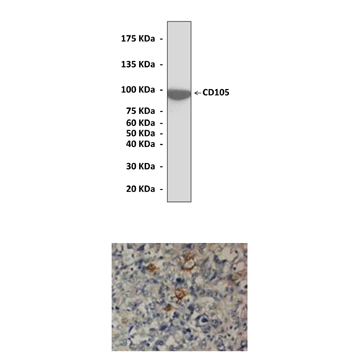Anti-CD105: Polyclonal Endoglin Antibody |
 |
BACKGROUND Endoglin (CD105) is a transmembrane glycoprotein expressed on activated vascular endothelial cells. It is an accessory protein of the transforming growth factor-beta (TGF-beta) receptor system and composed of two disulfide-linked subunits of 95 kDa each forming a 180-kDa homodimeric mature protein. Endoglin is expressed as two isoforms, designated long (L-CD105) and short (S-CD105), based on the length of the cytoplasmic domain. It is a marker of activated endothelium, and its vascular expression is limited to proliferating cells.1 Mutation of the endoglin gene is associated with hereditary hemorrhagic telangiectasias, or Osler-Weber-Rendu syndrome. In addition to its expression on endothelial cells, endoglin is found on the surface of several other cell types. The expression of endoglin is elevated on the endothelial cells of healing wounds, developing embryos, inflammatory tissues, and solid tumors. Several studies identified endoglin expression in several solid tumor types, with the level of expression correlating with various clinicopathologic factors including decreased survival and presence of metastases.2 Attempts to target endoglin and the cells that express this protein in tumor-bearing mice have yielded promising results.
Endoglin signaling is initiated by binding of TGF-beta and results in a series of activation steps leading to transcriptional activity. Endoglin binds several components of the TGF- superfamily including activin-A, BMP-7 and BMP-2. In particular, it binds TGF- 1 and - 3 with high affinity by associating with the TGF- type II receptor. TGF-beta ligand binds to a TbetaR-II homodimer, which then recruits the type I receptor ALK1 or ALK5 to form a heterotetrameric receptor complex. In endoglin-expressing cells, endoglin is included as a dimer in this receptor complex. TbetaR-II then phosphorylates either ALK1 or ALK5 in a highly conserved glycine/serine-rich cytoplasmic domain, causing a conformational change in the receptor. Signaling is propagated to the nucleus via phosphorylation of Smad proteins, which act as transcriptional coactivators or corepressors.3
Endoglin signaling is initiated by binding of TGF-beta and results in a series of activation steps leading to transcriptional activity. Endoglin binds several components of the TGF- superfamily including activin-A, BMP-7 and BMP-2. In particular, it binds TGF- 1 and - 3 with high affinity by associating with the TGF- type II receptor. TGF-beta ligand binds to a TbetaR-II homodimer, which then recruits the type I receptor ALK1 or ALK5 to form a heterotetrameric receptor complex. In endoglin-expressing cells, endoglin is included as a dimer in this receptor complex. TbetaR-II then phosphorylates either ALK1 or ALK5 in a highly conserved glycine/serine-rich cytoplasmic domain, causing a conformational change in the receptor. Signaling is propagated to the nucleus via phosphorylation of Smad proteins, which act as transcriptional coactivators or corepressors.3
REFERENCES
1. Letamendia, A. et al: J. Biol. Chem. 273:33011-9, 1998
2. Fonsatti, E. Et al: Oncogene 22:6557-63, 2003
3. lebrin, F. Et al: Cardiovasc. Res. 65:599–608, 2005
2. Fonsatti, E. Et al: Oncogene 22:6557-63, 2003
3. lebrin, F. Et al: Cardiovasc. Res. 65:599–608, 2005
Products are for research use only. They are not intended for human, animal, or diagnostic applications.
Параметры
Cat.No.: | CA1725 |
Antigen: | C-terminal sequence of human CD105 |
Isotype: | Affinity-Purified Rabbit Polyclonal IgG |
Species & predicted species cross- reactivity ( ): | Human, Rabbit, Rat, Mouse |
Applications & Suggested starting dilutions: | WB 1:500 - 1:1000 IP n/d IHC (Paraffin) 1:50 - 1:200 ICC n/d FACS n/d |
Predicted Molecular Weight of protein: | 95 kDa |
Specificity/Sensitivity: | Reacts specifically with CD105 of human, mouse and rat origin in immunostaining and western blotting, no cross-reactivity with other members of the family. |
Storage: | Store at 4° C for frequent use; at -20° C for at least one year. |
*Optimal working dilutions must be determined by end user.
Документы
Информация представлена исключительно в ознакомительных целях и ни при каких условиях не является публичной офертой








